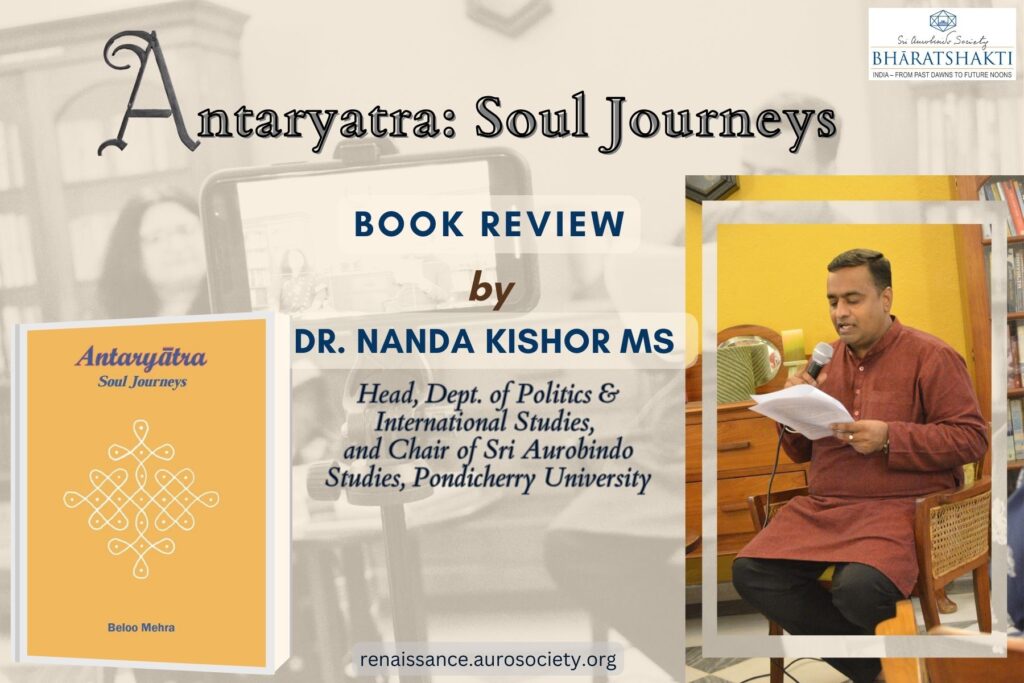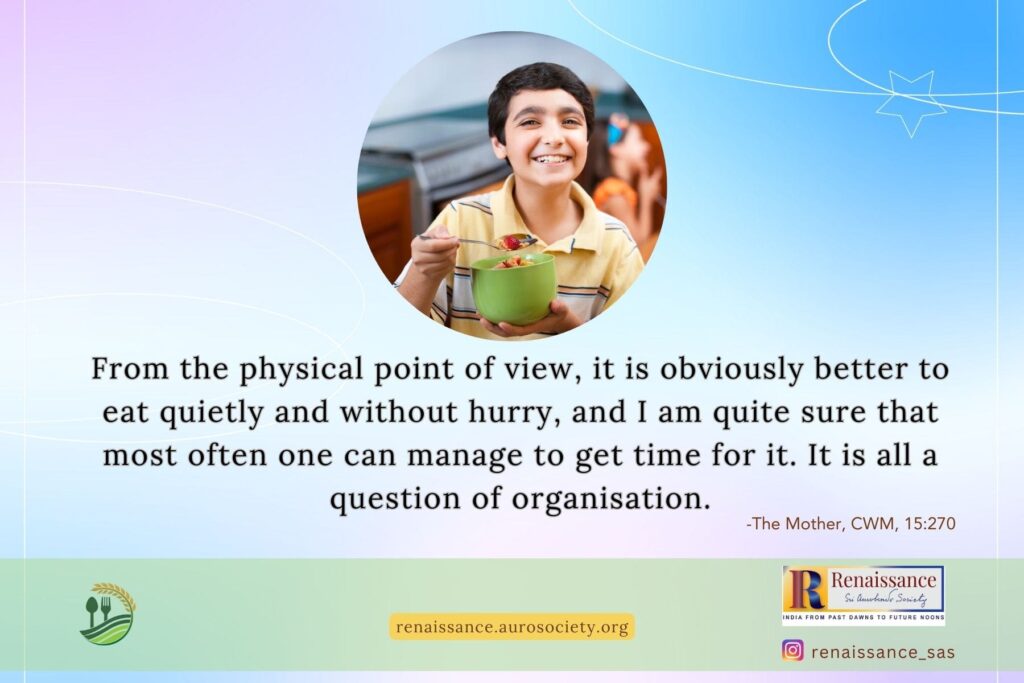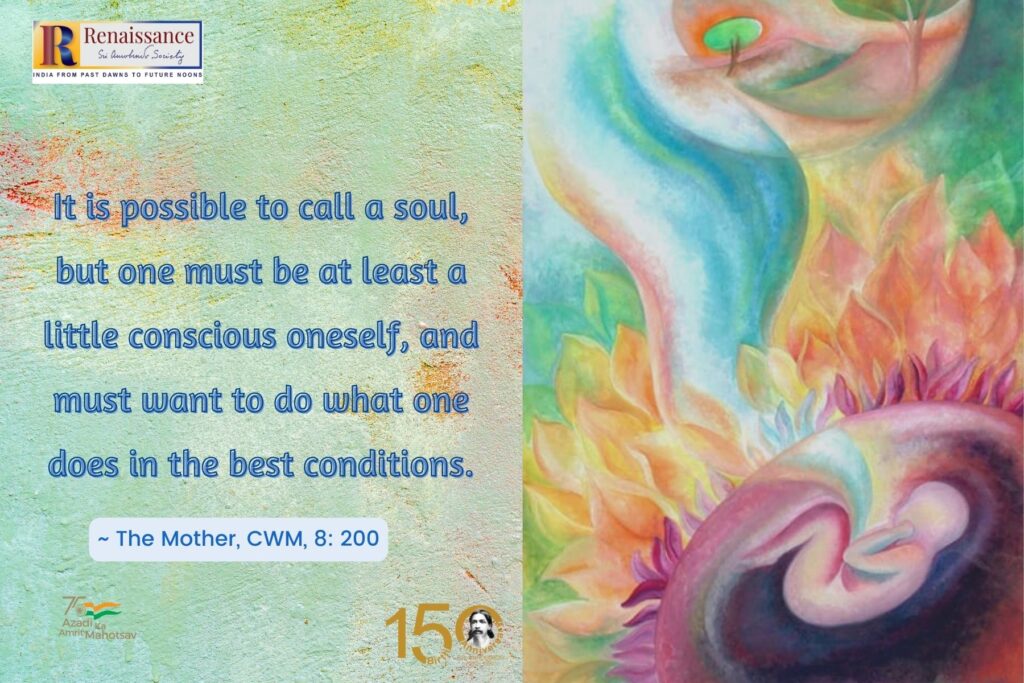Volume 1, Issue 5
Author: Pragya Upadhyay
Editor’s Note: We present an account of some important sessions conducted on Day 1 of the National Seminar on Prenatal Education: Ancient Indian Perspectives. Some key learnings from the sessions are described by one of the participants.

PART I
I had the wonderful opportunity to attend and also actively participate in the National Seminar on Prenatal Education: Ancient Indian Perspectives. This seminar, jointly organised by Sri Aurobindo Foundation for Indian Culture (SAFIC) and Sri Chandrasekharendra Saraswathi Viswa Mahavidyalaya (SCSVMV), was held at the SCSVMV campus at Kanchipuram on April 11th and 12, 2019.
In this report I provide a brief summary of the sessions I attended, particularly highlighting the major points which I found most educational. In this first part, I describe my leanings from some of the sessions conducted on Day 1 of the seminar. In the second part, the focus is on the sessions conducted on Day 2 of the seminar.
DAY 1
Rituals as a system of education
Our culture has never presented itself in isolated or exclusive way, rather it is recognised for its holistic and interwoven threads of philosophy, science, ethics, values, mythology and rituals, closely knit to form our cultural fabric. It is in the form of rituals (samskāra) that our ancient traditions and knowledge have been preserved, and passed on from generations to generations, thus sustaining the course of time for thousands of years, untarnished. Our ancient Indian teachings come in the form of convergence of Rituals-Philosophy-Science.
Social and spiritual implications of rituals
The discussion on rituals was facilitated by Dr. Ramaratnam in his keynote address at the inaugural session. He explained that every Indian ritual has some concealed symbolism. Though primarily they serve the social purpose of expressing and preserving the tradition, real significance of the underlying symbolism needs to be understood to decode their true scientific-spiritual implications.
This was beautifully explained by the example of vivāha samskāra (marriage rituals), in which one of the most important ritual is Pānigrahanam Saptapadi where the bride and the groom go around the sacred fire (the purest of all elements) seven times, with a backdrop of the sacred chanting of the Vedic mantras as a symbol of their impending marital union. While walking one after the other in circles, one cannot be said to be walking behind or ahead, and thus this symbolises truly the joy of living life with togetherness and companionship.
Another Vedic vivāha mantra was translated as, “I am your mind and you are my speech,” thus focusing on the need of complete interdependence, trust and synchronicity between the husband and the wife. Another ritual of observing 3 days of austerities and self-regulation after marriage serves the purpose of giving two people more time to become comfortable with each other, feel relaxed mentally and physically, and become physically, mentally and emotionally prepared for going ahead in their family life.
Speaking about the significance of prenatal and postnatal ceremonies, Prof. Ramaratnam said that Ritu Sangama (courtship period or sexual intimacy) should take place only from 5th day of menstruation to 16th day, except 11th and 13thday. And Nishekam, the ritual related to first intercourse, must happen only on the 4th night after marriage and not before it. It was highlighted that the practice of self-regulating the period of courtship, instead of negating the biological drives but limiting it only to these 10 days is termed as practicing Brahmacharya for the married couple.
The role of antenatal yoga in postnatal life
Yogacharya Dr. Ananda Balayogi Bhavanani emphasized the importance of sāttvic diet, and proper hydration during pregnancy. He also brought out the point that possible harmful effects of ultrasound scans and x-rays on the foetus, which are not being recognised now might be seen as a problem sometime in the future. Hence it was advised to get these examinations as less as possible (not more than 2-3 times during pregnancy).
He also threw light on the positive effects of common mantras, such as Gayarti Mantra and OM chanting which are now scientifically proven to have relaxation effect on both the mother and the child – at prenatal, perinatal and postnatal stage.
Yogacharya also highlighted the inevitable need for keeping the mother stress-free, both during and after pregnancy. And hence came an important suggestion from him regarding breastfeeding – “Don’t pressurise or judge the mother, the amount of milk being secreted by the body is sufficient for the particular child’s needs.
The love and nourishment can be transferred by the mother even with few drops of her milk, or even by her comforting physical presence, but one prerequisite to everything is that the mother needs to remain stress-free.”
Some yogic practices recommended as a preparation for pregnancy are kapalbhaati, sarvangasana. During pregnancy, it is recommended to go for an individualised yoga plan, involving pranayama-s such as nādishodhan, sheetli, suryabhedi, etc.
It was also highlighted that on internet, we don’t find images of Indian mothers, pregnant women, parents and children doing yoga together, hence signifying the need for creating more awareness and facilities in this direction.
Prenatal rituals in the Vedas
Dr. Rangan Ramakrishnangave insights on the 16 samskāra-s, out of which 3 are Prenatal – Garbhadhana (performed before conception), Punsavana (Foetus Protection performed in 4thmonth of the pregnancy), Simantonnayana (satisfying the cravings and keeping the mother happy performed in the 7th ); 1 is perinatal – Jatakarma (at the time of childbirth); followed by 3 samskāra-s for the infanthood – Namakaran (naming the child), Nishkramana (taking the child outdoors for the first time after 4 months from the birth), Annaprasana (giving solid food from 6thmonth); and 3 samskāra-s for early childhood – Mundana (hair cutting at 1stor 3rd year), Karnavedha (ear piercing in 3rd or 5thyear), and Upanayana (starting of the student life at 6 years).
Out of all, the samskāra of Jatakarma is the ritual specially focusing at the time of birth of the child and first few crucial hours of perinatal care. It is important to remember that both developmental psychologists and doctors recognise the time of birth and first few hours as the most crucial period for a child’s long-term development.
Jatakarma provides physical and psychological support, security and strength to the mother and the new-born. It emphasises the physical presence of the father at this essential time, chanting of sacred mantras, father helping in cutting of the umbilical cord and facilitating immediate skin to skin contact between the infant and the mother for at least the first couple of hours after birth by placing the naked infant on the bare breast and shoulder of the mother and initiating the breast feeding.
Thus, the samskāra of Jatakarma can be associated with modern day practice of Kangaroo Care. It reduces the chances or intensity of birth trauma encountered by the child and strengthens and improves the maternal attachment behaviour. It also helps reduce maternal anxiety, which researches show has a short term as well as a long-lasting impact on the woman’s life.
Preparations and cleansing as a tool for expecting mothers
Dr. M. Jayaraman presented a thought-provoking paper onYogasutra based citta-parikarma for Prenatal Education. He compared pregnancy to samapatti (samādhi) as both can be considered as a state of spiritual transformation. He explained how in the yogic school of thought, “what is done by the mind is much more real then what is done by the body.”
Hence while talking about the Birth Education and Care, more emphasis needs to be laid on preparing the mind than body. This makes psychological aspects of Prenatal Education so much more significant.
He spoke about seven preventive-therapeutic tools for prenatal care. These are: a) Emotional atonement, b) Breathing practices and asanas, c) Positive stimulus for the senses (directly and from the environment), d) Meditating on the light within to eradicate darkness and remain cheerful, e) Never letting the mother feel dejected and depressed, f) Reading and sharing inspiring and elevating stories, and g) Managing sleep and analysing dreams.
Stress was also laid on the social aspects of prenatal care, for example, the role of family members in providing positivity and cheerful internal and external environment for the mother.
Out of these seven tools, the most fascinating one was learning the stories of people with cardinal positive traits and listening to the positive birth-stories and pregnancy-stories from experienced women. Researches widely show how this can boost the confidence, develop self-efficacy and keep the expectant mother concentrated towards bringing similar personality traits in the child and becoming well prepared to boldly face all the stages of her pregnancy.
By connecting an island (one pregnant woman) to the continent (other experienced women of substance), a new revival of the forgotten traditional-feminine wisdom and familiarity with the birth process can be beautifully facilitated.
The use of imagination and visualization, along with being watchful of the quality of sleep and dreams by understanding the three states of seep & dreams – sāttvic, rājasic and tāmasic – was also highlighted. This can be used for interpreting the inner emotional and mental state of the mother, and as per the need, desired steps can be taken to transform tāmasic and rājasic states into sāttvic state.
Meditating on the deep sleep and dream experiences and any sāttvic object that one desires (within the framework of the Shāstras and as per the unique preferences of the mind of different individuals) can be one simple step toward it. For example, an expectant mother may visualise and meditate upon the image of Balakrishna, this can help calm down her mind, and also seed similar divine cardinal traits in the child, thus making the mother become aware and empowered.
Insights on embryo development
Dr. B. Chandrika presented a paper on embryo development as per some insights from the Shiva Gita. Generally, when we hear the word Gita, the first picture that comes to the mind is that of Bhagavadgita. But it was highlighted that there are as many as 28 Gita-s in our scriptures, Shiva Gita being one of the other most popular Gita-s.
This was certainly a new revelation for me as I learned that Shiva Gita is a Vedic text derived from Uttara Kanda of the Padma Purana and came much before Bhagavadgita. It is a dialogue between Lord Shiva and Sri Rama, where Lord Shiva narrates for Sri Rama the path of liberation. It has 18 chapters just like Bhagavadgita, and chapters 8, 9 and 10 give detailed insights on prenatal and embryo development.
Some important postulates from these chapters were discussed by Dr. Chandrika, such as: sexual intimacy between husband and wife to be enjoyed from 4th day of menstruation to 16th day only; having intercourse on odd dates and from left side results into birth of a female child, while having it on an even date from right side results in the birth of a male child.
She mentioned that the soul enters the embryo in 4thmonth and it is at this time that the mother is called “twin-hearted” as the heart of the embryo also forms and becomes functional, and the heart of the mother resonates with the newly formed heart of the child. From this time onwards, the mother’s desires are supposed to be influenced by the tendencies of the child, and thus they need to be strongly fulfilled, and if not, the child is born with those cravings.
Rajaswala Parichaya as a tool to enhance fertility
Dr. Roshni emphasised that menstrual health can be considered as a mirror of the reproductive health of a woman. She added that menarche should be celebrated as the true starting point of motherhood, and hence prenatal education should begin right from the age of puberty and must take into account awareness related to proper care during the menstruation period throughout the woman’s life span.
An awareness session on menstrual health and cultural sensitivity was conducted by Dr. N. Kalyani as part of the seminar. She educated the young girls about the physiological, psychological, social and spiritual significance of this auspicious cycle in a female’s life, that blesses her with a divine possibility of procreation.
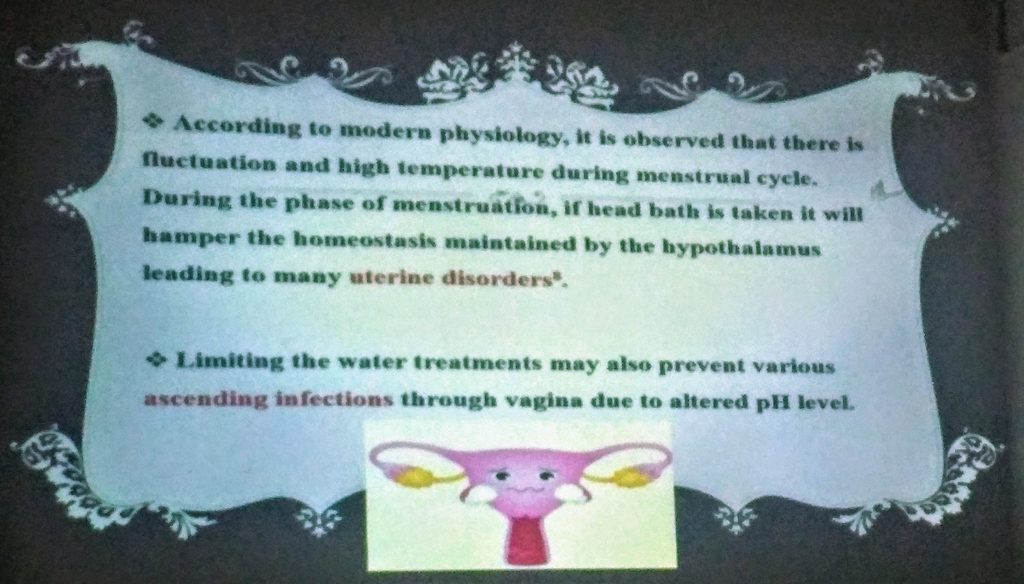
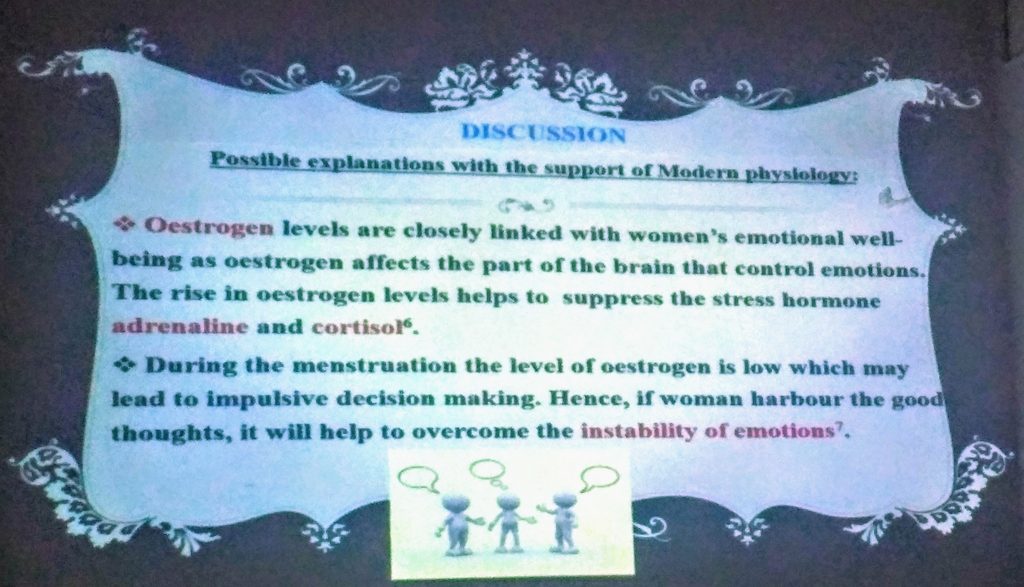
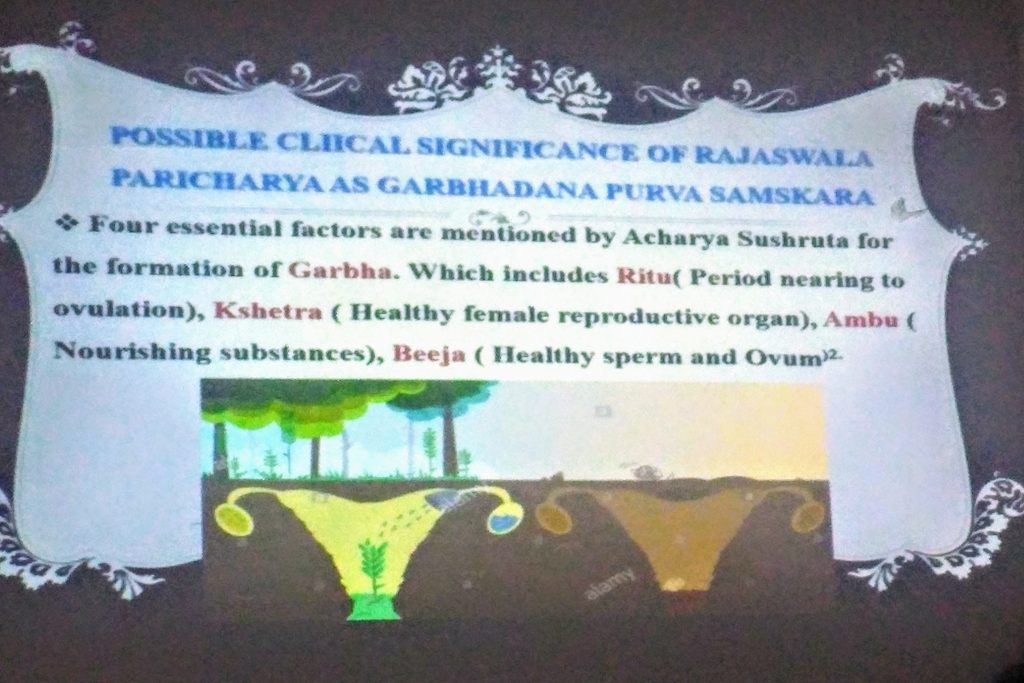
The Ayurvedic concept of shadbhavas, with special reference to supraja-janana
Dr. Geetha Kumar explained that shadbavas can be loosely translated into “the 6 houses of our life”. The 3 or the half of the factors relate to the physical formation of the body before birth, contributed by our bloodline and prenatal care – matrija (maternal influence), pitrija (paternal influence) and satmayayaja (Nutrition, internal and external environment during pregnancy).
The other 3 aspects are considered to be brought along with the soul (iīva) – rasaja (essence related to tridosha or body type constitution), satvaja (the degree of purity and karmic debt) and ātamaja (the degree of infusion of spirit and our spiritual history). Hence all these 6 factors together contribute towards supraja-janana. Though the last 3 factors are esoteric, there is a lot of scope for development and regulation in the first 3 factors, giving way to conscious conception.
Spiritual dimensions of fertility, pregnancy and childbirth from Ayurvedic perspective
Dr. P. Rammanohar’s presentation brought so many new insights for even the senior most scholars and Ayurvedic physicians in the audience. He raised some of the most significant questions and answered them with his deep understanding of the Ayurvedic wisdom. One such insight was regarding the importance of childbirth not only as a means for preserving the continuity of bloodline, but also for the transmission of samskāra.
Dr. Rammanohar highlighted a beautiful negative correlation between the Body and Mind in terms of ageing. Ageing can be defined by the time-related deterioration of the physiological functions necessary for survival and fertility at the level of body, but mind on the other hand evolves with time. Thus, healthy ageing should aim towards the expansion of Mind or Consciousness with time.
He also questioned the two end points of the linear equation of life as birth-reproduction-death. He invoked the idea of the relative simultaneity of birth-death, thus establishing how reproduction takes place continuously at every moment of our life at different planes of our existence. Therefore, he requested all to see sexuality as a part of the same intense desire of the life to proceed itself, which exists at cellular level, metabolic-catabolic level, and vital level, thus taking away special weightage from it.
He emphasised on dedicating life towards the goal of expansion of the consciousness. Even sleep cycle can be considered as dying each day and getting a rebirth each morning, and thus getting up at brahma-muhurat (2 hours before sunrise) could be helpful for expansion of consciousness.
Brahmacharya, often translated as celibacy, was accurately translated by him by dissecting it into two root words i.e. Brahma (Higher Consciousness) and Charya (Way), thus making it “The Higher Consciousness Way, or the path for the expansion of the mind.” Therefore, brahmacharya need to be understood as the modulation of our sexual energy rather than its negation, with the purpose of expanding one’s consciousness. Brahmacharya is not against sexuality, but sexuality can be against brahmacharya, if not regulated consciously.
He also talked about the four prerequisites of marriage as per “Āchara Rasayana”: 1) Having best sapta dhatus (7 tissues), namely, Rasa (plasma), Rakta (blood), Mamsa (muscle), Meda (fat), Asthi (bone), Majja (marrow/nerves) and Shukra (reproductive tissue); 2) Purification of Rasa Dhatu (fluid-nourishments: blood plasma, the lymph and interstitial fluids, etc.) which is responsible for producing the feeling of physical and psychological satisfaction; 3) Purification of the Rasayana (the path of the Rasa) in the light of the connection between the mind’s state of health and its effect on the body’s well-being; 4) Aiming and working towards the expansion of mind.
Therefore, before planning for marriage, individuals need to investigate where they stand in these four areas and how they can upgrade their qualities in order to become potent for suprajanan.
Another fascinating principle explained was of “Agni Soma”— a universal classification of the fundamental polarity of fire and water, described by taking in account the complimentary function they serve at microcosmic and macrocosmic levels, highlighting the fact that the whole world is essentially fire or water but it is the unity of the two which creates or manifests life.
Seventy percent of human body is water while all the processes in the body take place through the energy and transformation of fire element. Thus, the body is always in a state of finding a balance between “to burn or not to burn” in the words of Dr. Rammanohar.
The characteristic of the female reproductive organ is fiery, in contrast to the man’s reproductive organ which is of the nature of soma, but in juxtaposition to that the quality of ovum can be considered as saumya and of sperm can be considered as that of Agni. Agni element in women is controlled by the Soma element of the universe, i.e. moon.
While the Soma element of man is controlled by the Agni element of the universe i.e. Sun. Similarly, father is represented by the Sun while the mother is represented as the Moon in astrology, thus posing a mirror image. It is this union of the opposites that give way to new life in the form of an embryo.
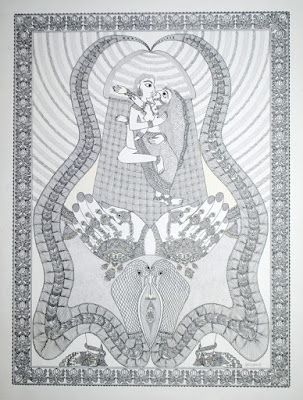
Another noteworthy point discussed by Dr. Rammanohar was the purpose of gender inadequacy, hence affirming a quest towards equity and unity through the union of both the sexes. The purpose of marriage is to attain this equity by supporting each other in fulfilling their respective needs and aiming for attaining the state of Bliss.
It is the journey from enjoying the limited rasa of conjugal enjoyment to tasting the perfect rasa of resting in ultimate higher consciousness. Vivāha as per its Sanskrit translation means – “to bear or carry off,” hence it needs to be sincerely considered as the vehicle for the transfer of genetic material and samskāra-s. Reproduction needs to happen only with this conscious purpose of transferring the best to the progeny and not unconsciously.
Another intriguing thing Dr. Rammanohar shared was about the meaning of word shankha, which translates into “auspicious space.” This is the reason for calling the female reproductive organ, uterus, as shankha, as it is the holy space where “agni-soma” come together and unite to produce the miracle of divine transformation at physical level.
Another sacred space that is called as shankha in our body is skull, where lies the confluence of the spiritual aspects of Shiva and Shakti (soma-agni). Hence the terms of agreement for a marriage are to meet both the goals – at the physical and at the spiritual level.
The womb is also called as the kshetra which means temple, rightly called so, as it serves the ground for the manifestation of higher consciousness. Thus, it was explained why ancient Indian temples have erotic images, because those remind the people of the highest purpose of sexual congress – that of transformation of the consciousness.
Meaning of the ritual of putting sindoor (red colour signifying fire) was explained as the expansion of the Agni tattva from the seed form (bindu) to the vertical, upward movementthrough trichion, indicating expansion and upward movement of the consciousness being assured by the husband. While meaning of the wife putting chandan tilak on the forehead of the husband was explained as the assurance of bringing Soma tattva or calmness to him. Thus, complimenting the gender differences by fulfilling each other’s needs thus contributes toward gender equity.
Continued in Part 2…
Cover image: Mother and child, by Ritam Upadhyay
Purusha and Prakriti: Art by Pushpa Kumari (source)

